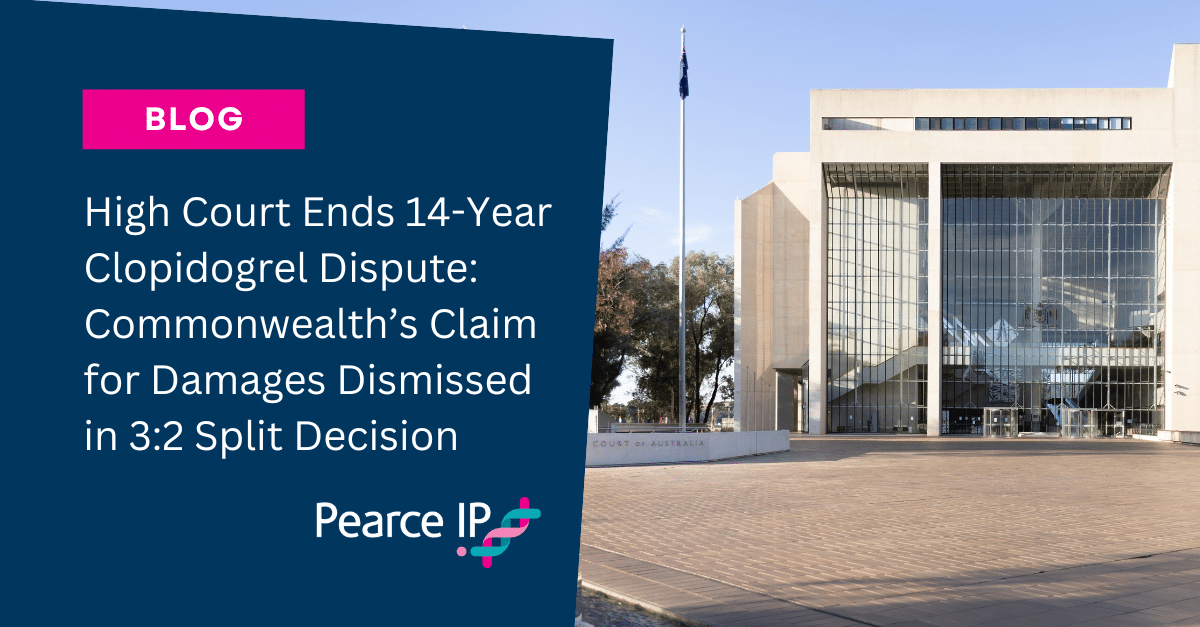| Date of decision: | 11 December 2024 |
| Body: | High Court of Australia |
| Adjudicator: | Justices Gordon A-CJ, Edelman, Steward, Jagot and Beech-Jones |
Highlight
In a split 3:2 decision, Gordon A-CJ, Edelman and Steward JJ of the High Court (the Majority) has dismissed the Commonwealth’s appeal in which the Commonwealth sought to overturn the decision of Justice Nicholas of the Federal Court of Australia (affirmed on appeal by the Full Court of the Federal Court) that the Commonwealth was not entitled to compensation on an undertaking as to damages given by Sanofi when it obtained an interlocutory injunction preventing Apotex Australia from launching generic clopidogrel products in Australia.
Justices Jagot and Beech-Jones delivered two strong dissenting judgments, finding that there were clear errors in the primary Judge’s and Full Court’s decisions which meant the appeal should be upheld. Both Judges also warned against bringing the administration of justice into disrepute given the apparent contradictory position which Sanofi put to Justice Gyles when it sought the interlocutory injunction (that is, that Apotex Australia would launch if an interlocutory injunction was not ordered) and later when it resisted the Commonwealth’s application for compensation pursuant to the undertaking as to damages (that is, that no such threat existed from Apotex Australia).
The High Court’s judgment brings to an end 14 years of patent litigation in relation to clopidogrel.
Background
Sanofi was the owner of Australian patent 1988011292 (the Patent) for the drug clopidogrel which is used to treat patients who have suffered or are at risk of a heart attack or stroke. Sanofi marketed its clopidogrel product under the brand name Plavix®. Sanofi sued Apotex Australia for patent infringement when Apotex Australia sought to launch generic clopidogrel products in Australia. On 25 September 2007, Sanofi gave the usual undertaking as to damages upon obtaining an interlocutory injunction against Apotex Australia which prevented Apotex Australia from launching its generic clopidogrel products in Australia. Apotex Australia separately undertook not to take steps to obtain listing on the Pharmaceutical Benefits Scheme (PBS) of its generic clopidogrel products. Sanofi was granted a final injunction at first instance. However, the Full Court of the Federal Court overturned this final injunction on appeal, ordering that the Patent be revoked. The High Court refused Sanofi’s special leave application.
On 11 April 2013, the Commonwealth commenced proceedings on the undertaking as to damages, alleging that, but for the interlocutory injunction, Apotex Australia would have obtained PBS-listing of its generic clopidogrel products on 1 April 2008 which would have led to a reduction in prices for clopidogrel products. Justice Nicholas (the primary judge) dismissed the Commonwealth’s application, finding (in summary) that:
- approximately $314 million (out of the Commonwealth’s $325 million claimed loss) was not within the scope of the undertaking as to damages, because “the interlocutory injunction and the undertaking given in support of it were ‘totally eclipsed’ by the grant of the final injunction”; and
- the Commonwealth had not proven on the balance of probabilities that Apotex Australia would have sought and obtained PBS-listing for its clopidogrel products from 1 April 2008 if the interlocutory injunction had not been granted.
The Full Court of the Federal Court (the Full Court) on appeal upheld Justice Nicholas’ decision, unanimously affirming the reasoning and ultimate conclusion of the primary judge. See here for our report on the Full Court’s decision.
Key Issues and Consideration
Majority Judgment
The Majority framed the two key issues before the High Court as being:
- The onus of proof in a claim made on an undertaking as to damages, and whether, based on the facts before the courts, the Commonwealth had discharged its onus of proof. The Commonwealth alleged that the Full Court erred in not holding: (i) that the Commonwealth’s evidential burden was to establish a prima facie case that its loss flowed directly from the interlocutory injunction; and (ii) that, once that was established, an evidential burden shifted to Sanofi to establish that Apotex Australia would not have sought listing on the PBS even if not enjoined.
- Whether the Full Court erred in failing to find, by inference from the evidence, that, if there had been no interlocutory injunction, it was likely that Dr Sherman (co-founder of Apotex Inc, its Chief Executive Officer and Chairman and the “ultimate controller” of the Apotex group (including Apotex Australia)), would have reconfirmed the plan for Apotex Australia to seek PBS-listing.
The Majority held against the Commonwealth on the first key issue, affirming that no rigid legal rule constrains how the evidential onus may shift in a proceeding assessing compensation on an undertaking as to damages. The High Court considered that the Commonwealth bore the legal and evidentiary onus of proof on causation of loss within the scope of the damages undertaking during the term of the interlocutory injunction (25 September 2007 when the interlocutory injunction was granted and 19 August 2008 when Justice Gyles ordered the final injunction). This meant that the Commonwealth was required to establish on the balance of probabilities that Apotex Australia would have sought and obtained PBS-listing but for the interlocutory injunction.
Turning to the second key issue, the Majority stressed the limited circumstances in which the High Court should review findings of fact made by a primary judge, which were not disturbed by the intermediate appellate court. This meant that, absent any issue as to individual rights or special or exceptional circumstances such as plain injustice or clear error, the High Court would not undertake a detailed review of concurrent (intermediate and ultimate) factual findings of lower courts. In the Majority’s opinion, the appeal did not raise any issue as to individual rights and the primary judge’s and Full Court’s reasoning was not clearly wrong or productive of injustice.
Ultimately, the Majority held that that the concurrent findings of fact made by the primary judge and the Full Court, which supported the conclusion that Apotex Australia would not have sought and obtained listing of its clopidogrel products on the PBS on 1 April 2008, and so would not have launched its generic products if it had not been subject to the interlocutory injunction, were open and were not clearly wrong. Further, and in any event, the Majority considered that it was not open to the Commonwealth on appeal to revisit many of the factual findings that it sought to reopen.
The Majority considered that the following four significant reasons established that the concurrent findings were both open, free from clear error and compelling:
- First, the decision as to whether to launch at risk was to be made by Dr Sherman and any intention that Dr Sherman had to launch at risk in September 2007 was conditional.
- Secondly, even if Dr Sherman held an intention in early September 2007 to launch at risk, the concurrent findings of the primary judge and the Full Court were that two unexpected events in September 2007 might have changed Dr Sherman’s mind about launching at risk in Australia. The first unexpected event was that Apotex Australia inadvertently missed the 1 September 2007 deadline for applications for PBS-listing by 1 December 2007. The second unexpected event was that Justice Gyles, the judge who would hear the interlocutory injunction, informed the parties of his preference for an expedited final hearing. Taken together, these two unexpected events meant that the launch at risk would occur, at the earliest, only four weeks before the trial concerning the validity of the Patent and approximately 4 months before a judgment from that trial would be delivered by Justice Gyles (prior to his retirement from the Federal Court).
- Thirdly, the concurrent findings of the primary judge and the Full Court were that a risk/return analysis might have affected a final decision as to whether to launch at risk, particularly given the imminent trial and judgment from that trial which would have removed any risk.
- Fourthly, at the relevant time, and with the benefit of risk/reward analyses, Mr Kay (President of Apotex International Inc) expressed serious doubts about whether to launch at risk, pending an appeal, if Apotex Australia was successful in invalidating Sanofi’s patent.
Justice Jagot
Justice Jagot disagreed with the Majority, holding that:
- This was not a case in which the principle of appellate restraint in the face of relevant concurrent findings of fact by the Courts below was engaged, as the primary judge and the Full Court had not “confronted the evidence and reached a conclusion informed by that confrontation”.
- On the evidence before the Courts, the primary judge’s and the Full Court’s reasoning process involved clear error resulting in plain injustice and demanding the High Court’s intervention. In particular, Justice Jagot considered that the best evidence of what Dr Sherman could or would have done in response to the two unexpected events was what he in fact did (which was to continue to pursue PBS-listing and launch of Apotex Australia’s clopidogrel products on 1 April 2008).
- Given the clear errors in the primary judge’s and Full Court’s decisions, it would have been plainly unjust if the High Court did not consider the whole of the evidence the parties put before it to determine the Commonwealth’s appeal. Further, the potential injustice was all the greater given that the Commonwealth was the only person other than Apotex Australia to have been at a real risk of loss from the (ultimately) wrongful grant of the interlocutory injunction.
- Once the Commonwealth’s case and all of the evidence the Commonwealth relied upon were considered, the unavoidable conclusion was that the Commonwealth proved that, but for the grant of the interlocutory injunction on 25 September 2007, Apotex Australia would have applied for (and obtained) PBS-listing of its generic clopidogrel products and would have launched these products in Australia on and from 1 April 2008.
Justice Jagot also disagreed with the Majority on the risk/return analysis. In her Honour’s view, the “potentially ruinous damages” which Apotex Australia faced would only arise if Apotex failed to have the Patent declared invalid and revoked, an eventuality which the evidence indicated that Dr Sherman considered was most unlikely. Against that low risk of Apotex Australia failing to have the Patent declared invalid and revoked, there was an “enormous upside” for Apotex if it obtained PBS-listing and launched its clopidogrel products in Australia.
Justice Jagot went on to provide two warnings:
- First, to warn against the relative unreliability associated with any witness giving hypothetical evidence of what they would have done in a past hypothetical situation, compared to “contemporaneous documentary and other contextual evidence [which] was available in this case to inform the assessment of the possibilities and the probabilities relevant to the ultimate question”. On this point, Justice Jagot noted that Mr Millichamp (Apotex Australia’s Managing Director), who was responsible for implementing Dr Sherman’s decisions in Australia, was called to give evidence. This meant that, having called Mr Millichamp to give evidence, there would have been no expectation of the relevant kind that the Commonwealth must also call Dr Sherman to give evidence, which would thereby engage the kind of inference considered in Jones v Dunkel.
- Secondly, to warn against bringing the administration of justice into disrepute in circumstances where one judge was persuaded that there was a real threat of potentially unlawful action requiring restraint, only for another judge years later to conclude there was no such threat at all. This issue arose from the apparent contradiction between:
- Sanofi having sought an interlocutory injunction (with the associated undertaking as to damages), acting in good faith on a reasonable belief that: (a) if not restrained, Apotex Australia would carry out the threatened act; and (b) if it was ultimately wrong about its legal right to prevent that act, it would be liable to not only to Apotex Australia but also to adversely affected third parties; and
- Sanofi now contending that the very thing which it sought to prevent by obtaining the interlocutory injunction would not have occurred in any event.
Justice Beech-Jones
Justice Beech-Jones agreed with Justice Jagot’s reasoning on all issues, subject to the specific matters his Honour addressed in his judgment.
Like her Honour Justice Jagot, Justice Beech-Jones considered that:
- The primary judge and the Full Court did not properly address the Commonwealth’s case, and that there was both “clear error” as well as a “plain injustice” to the Commonwealth because its case was not addressed on its merits.
- The Commonwealth had “overwhelmingly” proven that, had the injunction been refused, Apotex Australia would have sought and obtained a PBS-listing of its clopidogrel products with effect from 1 April 2008 and launched in Australia.
Justice Beech-Jones also sounded a warning in relation to the apparent contradictory position which Sanofi put to the Court when it sought the interlocutory injunction and later when it resisted the Commonwealth’s application for compensation on the undertaking as to damages. His Honour stated at [340]:
The premise of the reasoning of the courts below is that if one of those litigants informed a court that, absent an injunction restraining them from doing so, they intended to launch a product on the market when that was not their intention, then that would not be deceitful conduct attracting severe consequences. That premise should not be countenanced. When the unequivocal statements made on behalf of Apotex Australia … to the Federal Court of Australia on 18 September 2007 about its intention to launch its range of clopidogrel pharmaceutical products are understood in that context, then the findings of the courts below cannot be sustained and the appellant, the Commonwealth of Australia, should succeed.
His Honour, however, went on to state that:
- There was no evidence that Mr Millichamp’s evidence did not represent his understanding of Apotex Australia’s intentions or that Apotex’s Senior Counsel’s statements to Justice Gyles did not genuinely represent his instructions.
- While Dr Sherman was its directing mind, Apotex Australia had already committed to PBS-listing and launching at risk by informing Justice Gyles that it would do so. Although the statements made concerned Apotex Australia’s future intentions, they were made to a court and so could not be withdrawn without good reason. This meant that there was no scope for any application of Jones v Dunkel or any analogous principle to detract from the evidentiary force of the statements made to Justice Gyles.
Outcome
So, in a split 3:2 decision, the High Court dismissed the Commonwealth’s appeal in which the Commonwealth sought to overturn the decision of Justice Nicholas (affirmed on appeal by the Full Court) that the Commonwealth was not entitled to compensation on an undertaking as to damages given by Sanofi when it obtained an interlocutory injunction preventing Apotex Australia from launching generic clopidogrel products in Australia.
Implications
The High Court’s decision sets out the key principles which are applied when the High Court determines appeals from lower courts, such as the Federal Court of Australia. While the five High Court judges hearing the Commonwealth’s appeal agreed on these key principles, the judges differed in the application of these principles to the facts of the Commonwealth’s appeal. This ultimately led the Majority to dismiss the appeal, holding that there were no individual rights in issue and no special or exceptional circumstances such as plain injustice or clear error.
In their two dissenting judgments, Justices Jagot and Beech-Jones critically warned against bringing the administration of justice into disrepute given the apparent contradictory position which Sanofi put to Justice Gyles when it sought the interlocutory injunction (that is, that Apotex Australia would launch if an interlocutory injunction was not ordered) and later when it resisted the Commonwealth’s application for compensation pursuant to the undertaking as to damages (that is, that no such threat existed from Apotex Australia).
About Pearce IP
Pearce IP is a boutique firm offering intellectual property specialist lawyers, patent attorneys and trade mark attorneys to the life sciences industries (in particular, pharmaceutical, biopharmaceutical, biotech, ag-tech and food tech). Pearce IP is the 2021 ‘Intellectual Property Team of the Year’ (Lawyers Weekly Australian Law Awards) and was shortlisted for the same award in 2022. Pearce IP is ranked in IAM Patent 1000 and Managing IP (MIP) IP Stars, in Australasian Lawyer 5 Star Awards as a ‘5 Star’ firm, and the Legal 500 APAC Guide for Intellectual Property.
Our leaders have been recognised in virtually every notable IP listing for their legal, patent and trade mark excellence including: IAM Patent 1000, IAM Strategy 300, MIP IP Stars, Doyles Guide, WIPR Leaders, 5 Star IP Lawyers, Best Lawyers, and Australasian Lawyer 5 Star Awards, and have been honoured with many awards including Australian Law Awards – IP Partner of the Year, Women in Law Awards – Partner of the Year, Women in Business Law Awards - Patent Lawyer of the Year (Asia Pacific), Most Influential Lawyers (Changemaker), among other awards.

Naomi Pearce
CEO, Executive Lawyer (AU, NZ), Patent Attorney (AU, NZ) & Trade Mark Attorney (AU)
Naomi is the founder of Pearce IP, and is one of Australia’s leading IP practitioners. Naomi is a market leading, strategic, commercially astute, patent lawyer, patent attorney and trade mark attorney, with over 25 years’ experience, and a background in molecular biology/biochemistry. Ranked in virtually every notable legal directory, highly regarded by peers and clients, with a background in molecular biology, Naomi is renown for her successful and elegant IP/legal strategies.
Among other awards, Naomi is ranked in Chambers, IAM Patent 1000, IAM Strategy 300, is a MIP “Patent Star”, and is recognised as a WIPR Leader for patents and trade marks. Naomi is the 2023 Lawyers Weekly “IP Partner of the Year”, the 2022 Lexology client choice award recipient for Life Sciences, the 2022 Asia Pacific Women in Business Law “Patent Lawyer of the Year” and the 2021 Lawyers Weekly Women in Law SME “Partner of the Year”. Naomi is the founder of Pearce IP, which commenced in 2017 and won 2021 “IP Team of the Year” at the Australian Law Awards.

Helen Macpherson
Executive, Lawyer (Head of Litigation –Australia)
Helen has over 25 years’ experience as an intellectual property specialist and is recognised as an industry leader. Helen advises on all forms of intellectual property including patents, plant breeder’s rights, trade marks, copyright and confidential information.
Throughout her career, Helen has maintained a strong focus on high-value patent mandates involving complex technologies. In these mandates, Helen has been able to draw upon her technical training in biochemistry and molecular biology, as well as her ability to up-skill swiftly in relation to diverse technologies. Helen’s patent work has encompassed the technical fields of inorganic, organic, physical and process chemistry, biochemistry, biotechnology (including genetics, molecular biology and virology) and physics.
Helen is a member of the Intellectual Property Committee of the Law Council of Australia, as well as a member of the Intellectual Property Society of Australia and New Zealand.

Nathan Kan
Lawyer
Nathan is a lawyer focused on providing legal services and advice to life sciences clients, with a focus on litigation support regarding intellectual property (patents, trade marks, designs, copyright, domain names, plant breeders rights and confidential information) and commercial disputes.
Nathan is passionate about the intersection of law and science. Whilst serving as Sponsorship Director and subsequently as Vice President of the Science and Technology Law Association (SATLA) at the University of Melbourne, he led various engagement events, workshops and publications covering a range of STEM fields, including life sciences, artificial intelligence and digital transformation.

